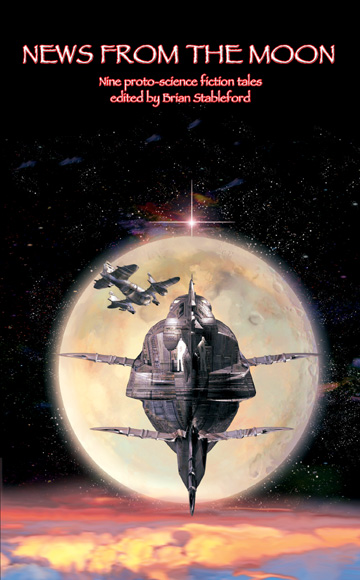Review by Glenn Russell
We come to understand French
speculative fiction is a distinct tradition, January 21, 2014
After centuries dominated by
the church and after the 18th century’s age of reason, there was
an explosion of imagination in the 19th century. From the romanticism
of poets and painters such as Byron, Keats, Delacroix and Turner to the
philosophy of such visionary thinkers as Hegel, Schopenhauer, Kierkegaard
and Nietzsche, from Darwinian evolution, Marxist economics, Freudian psychoanalysis
to the astonishing new scientific and technological discoveries, human
nature, history, society and the universe came to be seen in unique, fresh
and sometimes disturbing ways.
Brian Stableford’s 14
page introduction provides the historical and literary context for the
9 French proto-science fiction stories in this collection, including how
the French writers have the longest standing history of speculative fiction
based whole or in part on scientific ideas. Among the better known authors
examined within the world of French literary-scientific fiction are Jules
Verne and Théophile Gautier and Victor Hugo. We come to understand
French speculative fiction is a distinct tradition not to be limited or
confused with what we traditionally think of as science fiction. Here
is a brief review of 5 of the 9 tales:
News from the Moon –
Louis-Sebastien Mercier
Although written in 1768, the spirit of this tale is very much part of
19th century romanticism beginning with the first sentence: “The
account I am writing is perfectly true, although the reader might deem
me a madman.” A truly remarkable account – communicating with
a departed friend living in more rarefied form and answering questions
from his position on the moon. By way of example, here is what his friend
has to say, “Science, uncertain on Earth, is supported here by the
clearest evidence. There is no object that our eyes cannot easily penetrate
. . . “. Ah, proto-science fiction! A man living in a form beyond
the grave underscores how his experience is supported by the evidence
of science.
The Future Phenomenon –
Stéphane Mallarmé
With uncanny and almost eerie foresight, Mallarmé anticipates the
genre of post-nuclear war fiction with this short-short story. The symbolist
poet/author pens how in some barren, dusty, earth-scorched future husbands
and their bald, ghastly-looking wives enter a tent erected by the 'Showman
of Past Things' to see a display of a beautiful naked women with a full
head of blond hair. “When all have contemplated the novel creature,
a relic of some earlier accursed age – some indifferently, for they
will not have the power of understanding, but others heart-broken, their
eyelids moist with tears of resignation – they will look at one another.”
”Mallarmé invites us to reflect on what life would be like
in a future completely devoid of beauty.
The Metaphysical Machine
– Jean Richepin
Instead of an inquisitive English scientist exploring the future as we
find in H.G. Well’s ‘The Time Machine’, Richepin’s
short tale features an obsessed French madman exploring metaphysical truth
by a machine that looks something like the Englishman’s time machine
but with two important differences: a dentist’s drill rigged up to
produce excruciating pain in his hollow tooth and a mechanized scroll
enabling the Frenchman to write as he undergoes his torment. Sounds crazy?
It is crazy, although the narrator repeatedly insists he is not mad. At
one point in his frenzied telling, our philosophical pioneer exclaims,
“Besides the external senses and the internal senses, there is another
sense, internal and external at the same time, knowing its object as the
external senses do, immaterial as the internal senses are, but having
absolutely nothing in common with either of them – and that is the
SENSE OF THE ABSOLUTE.” Now, where does all this lead us? Does the
French visionary survive his adventure as does Well’s English scientist?
Let me just say this tale is taken from a collection of Jean Richepin
stories entitled ‘Moris bizarres’ (Bizarre Deaths).
The Monkey King – Albert
Robida
A tour de force of imagination, this rollicking 130 page adventure tale
has our hero lost at sea as an infant before being washed ashore on an
island where he is then raised by a community of warmhearted and wise
apes. There are all sorts of fabulous happenings when the hero moves back
to the world of men and eventually becomes a courageous and creative ship
captain. Here is an example of the dozens of adventures, when the hero,
Saturnin Farandoul by name, and his companion, wear diving gear and explores
the ocean: “Armed to the teeth with hatchets in hand and two pistols
operated by compressed air in their belts, along with sharp knives, the
mariners threw themselves upon the slimy rocks and ventured into caverns
inhabited by monsters unknown to man, which only the most deranged imagination
could have dreamed up: six-meter-long lobsters, sea-crocodiles, torpedo-squids,
crabs with a thousand feet, sea serpents, finned elephants, giant oysters
and so on.” Albert Robita’s tale is not only sheer adventure
in the tradition of Odysseus and Sindbad but prompts us to reflect on
our human interaction with the planet and other species.
Martian Mankind – Guy
de Maupassant
A pint-sized, bespectacled mousy visitor enters the study of the gentlemanly
narrator and excitedly discloses many scientific facts about the planet
Mars and mixes in details of the appearance and movements of the Martians,
all the while insisting he is not mad. The visitor then goes on to relate
his own first-hand experience of a Marian expedition to Earth. We read,
“I perceived, directly above me, very close, a luminous transparent
glove, surrounded by immense beating wings – at least I thought I
saw wings in the semi-darkness of the night.” Hardly an isolated
sighting, fiction or real-life, in the 19th century’s explosion of
imagination.
|


